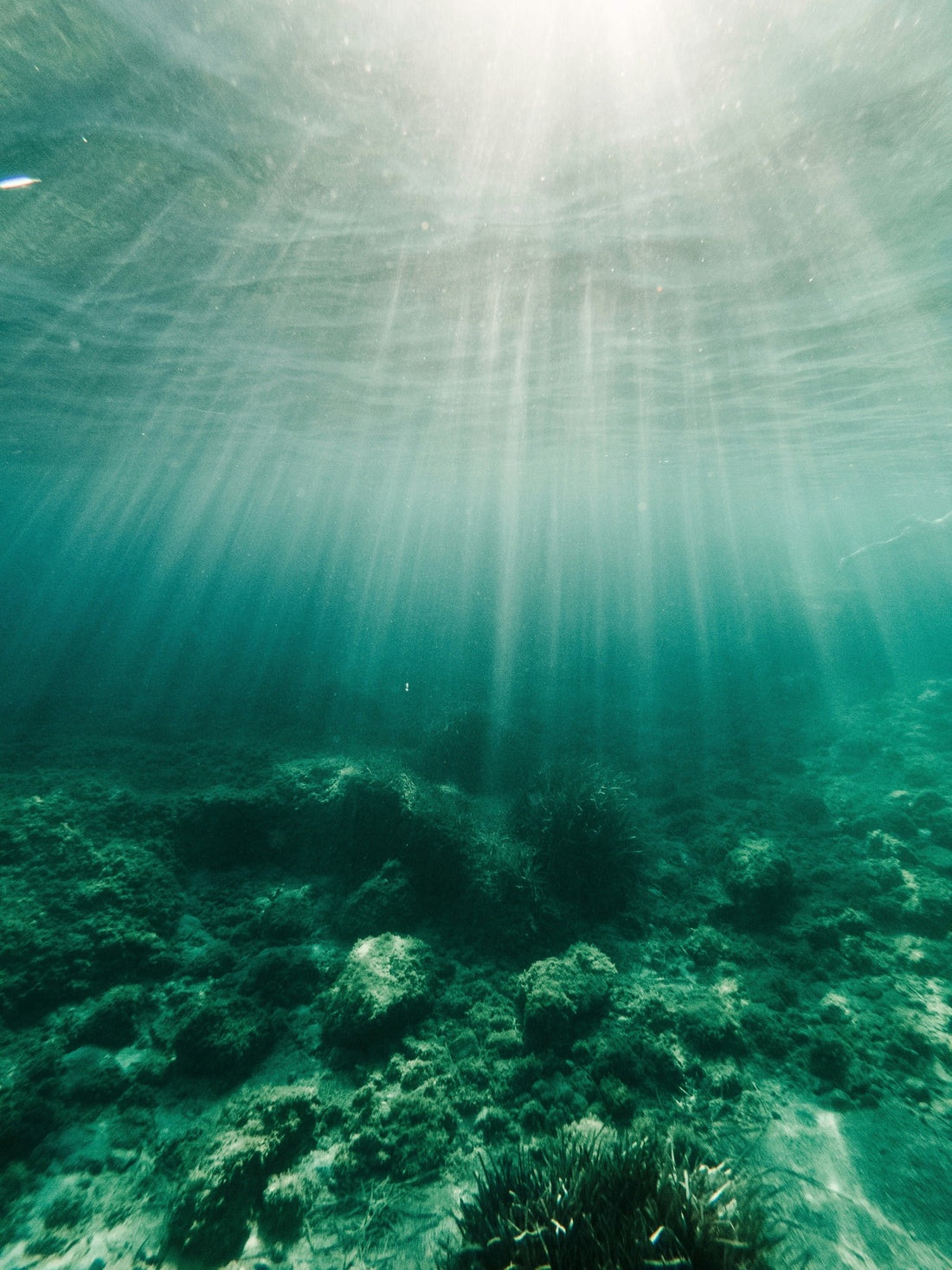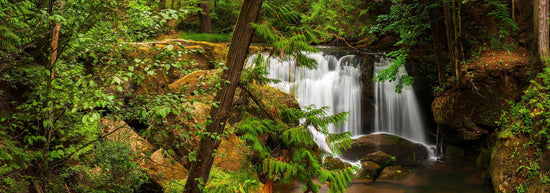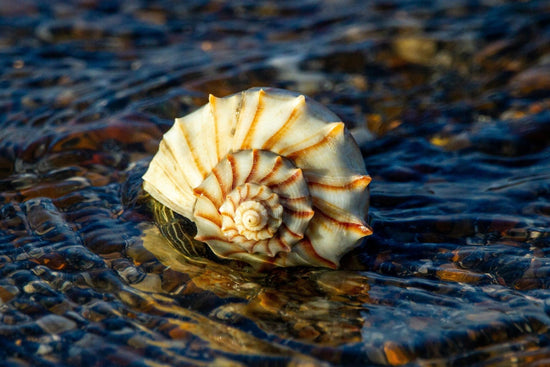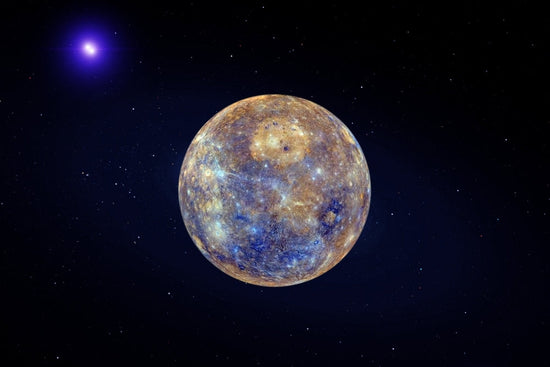Human from the waist up, fish from the waist down: The iconic mermaid has captivated human cultures around the globe for thousands of years. While Hans Christian Andersen (and, later, Disney) cemented the mermaid’s classically beautiful image in his 1836 fairytale The Little Mermaid, there are plenty of other merfolk teeming beneath the surface: some who roam the seas with little concern for the affairs of human life, others lurking below with much more insidious intent.
Most stories of real-life mermaids appearing to humans are (often inebriated) misidentifications of dolphins, seals, and manatees, yet many swear by their belief in the folk who fare beneath the tide. From Mesopotamia and Ancient Greece to Southeast Asia and the British Isles, mermaids are ubiquitous in human folklores, alive today even in an all-too familiar logo depicting the two-tailed siren, Melusine.
This week, in celebration of International Mermaid Day (March 29), we invite you to join us on a dive into the deep waters of mermaid mythology. The stories we focus on in this article are primarily of European origin, yet there are a plethora of other fascinating merfolk tales from around the world we think you would enjoy as well! Find our resource library for further learning at the end of this post.
Origins of the Mermaid: Atargatis
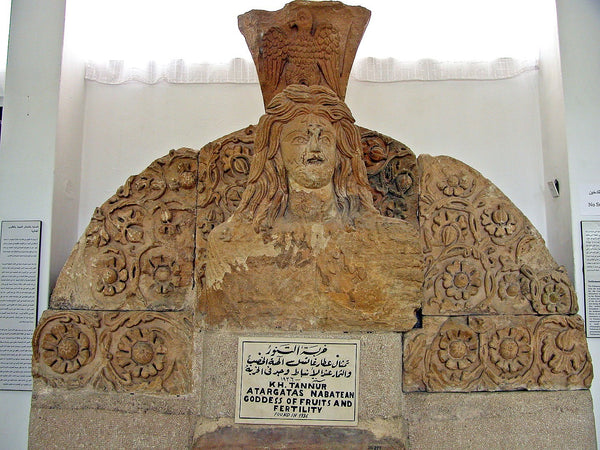
Statue of Atargatis at the Nabatean temple at Khirbet Tannur. Photo by archer10 (Dennis).
The earliest mermaid tale comes from Mesopotamia, 3,000 years ago. It begins with the Assyrian deity Atargatis, a powerful goddess of fertility and protector of her city and its people. Storytellers say she fell in love with a shepherd named Hadad, whom she married. One day, she accidentally caused his death. In grief and despair, Atargatis fled to a lake, attempting either to drown herself to be reunited with her lover, or to take the form of a fish.
However, the water was not powerful enough to conceal her divine beauty. Instead, she was transformed from the waist down, her lower half extending into a scaled, fish-like tail.
Due to lack of evidence from scholarly sources, it is unclear whether this story is truly grounded in history. Whether by syncretism or conflation, Atargatis is given the Greek form Derceto, considered a form of the goddess Aphrodite, and connected to the Phoenician Astarte and Anatolian Cybele. Many folklorists today regard Atargatis as the first mermaid from which all the other tales descend.
Sirens, Rusalki, and Nixies

The Siren (1900) by John William Waterhouse
One common theme among mermaid tales is that of luring sailors or other unwitting folk to their deaths—a trope appearing in many stories of sirens, rusalki, and nixies, who are frequently used as fables about the dangers or sinfulness of temptation.
Most well-known among them is the siren, a mermaid-like woman who sits among the rocks in the sea. The siren sings with such bewitching beauty that sailors lose all power of self-control upon hearing her sound, throwing themselves overboard to chase after her. The sirens are quick to snatch their prey, either dragging them to the bottom of the ocean or feasting upon their mortal flesh.
These famed sirens come from Greek mythology, though you may be surprised to know they originally took a far different form from the one we’re familiar with today. Initially appearing in Homer’s The Odyssey, sirens began as beings that were half-human, half-bird!

Odysseus and the Sirens (1891), by John William Waterhouse, shows the Greek warrior-king bound to his ship's mast as the Sirens' song calls to him.
Just how the sirens morphed from human-bird chimeras into mermaids is uncertain, though it seems likely they were conflated with other stories of sea folk who sang to entrance their prey.
One such creature is the rusalka (pl. rusalki) from Slavic mythology. These water spirits are said to be the souls of drowned women or girls, or children who died unbaptized. They appear thinly clothed by mist or light dresses and wreathed with crowns of sedge, living either in lakes or in crystal palaces in the depths of rivers. The rusalki emerge from their homes in the spring and summer, where they perform rituals of song and dance to “promote the growth of rye,” sometimes involving the death of any man who joins them.
While all rusalki are known to sing enticing music, not all are so malevolent—in fact, they may have initially been regarded as benevolent spirits. The rusalki of northern Russia are said to be particularly wicked and keen to use their gifts for torture, yet their kin around the Danube River, the vile (sing. vila) sing only to enchant the passersby.

Ivan Kramskoi, Rusalki ("The Mermaids"), 1871
Another siren-like story is that of the Germanic nix or nixie, a water nymph similarly dwelling in an underwater palace and said to be half-human, half-fish. However, the nixies are known shapeshifters, often taking the form of women to blend in among humans. These melophiles mean certain death, bewitching men with their songs or dance and coaxing them toward the water, where there can be no escape.
The most prominent legend of a nixie tells of a woman called Lorelei. As the story goes, Lorelei was distraught with a broken heart and threw herself into the Rhine River in Germany, where she was transformed into a water nymph who would seduce fishermen to their deaths. Because of this, many refer to her as a siren.
This story arose from the Lorelei Rock itself, a large slate rock along a narrow section of the Rhine river gorge. The rock itself seems to produce an echo, and, due to the surrounding treacherous waters, has been the site of many a shipwreck throughout history—which was likely the inspiration for the siren story!

The Lorelei Rock in 1900.
Today, some refer to nixies as Rheintöchter, or Daughters of the Rhine, in reference to Lorelei’s perilous and sorrowful legacy.
Merrows and Selkies
Over in Ireland we find another siren-esque creature in the merrows, sometimes called sea faeries. Their name comes from the Irish murúch, literally meaning sea-maid—perhaps a younger relative of the older, fishier merdúchann. It is said the merrows gain their power to live underwater by way of a red, feathered cap called a cohuleen druith. While the menfolk of the species are seen as ferocious and repulsive, depicted as “scaly with flat-faced, pig-like features and very long, sharp, shark-like teeth,” their feminine counterparts are of a far fairer ilk.
Merrow women appear generally true to the ethereally beautiful mermaids we all know well, with long fishtails and thin webbing between their fingers. Some say merrow men are so ugly that merrow women seek out human lovers instead, sometimes luring them with song or otherwise taking them against their will to live under the water, often as hostages, kept alive with magical enchantments. They can try to escape only at the risk of the merrow’s fury: If she catches her hostage attempting to flee, she may be filled with a murderous rage, sometimes causing grave storms fatal to sailors above, and other times drowning or eating the human she loved.
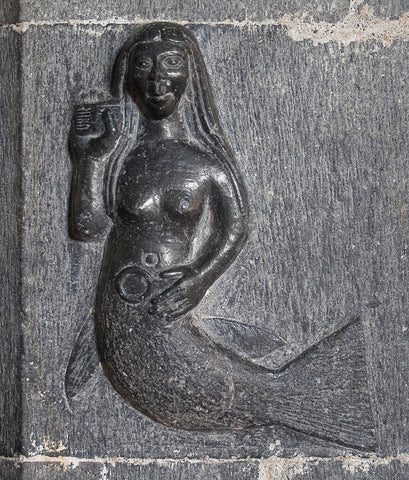
15th-century carving of a mermaid with comb and mirror at the southern pier of the chancel arch at Clonfert Cathedral, Clonfert, County Galway, Ireland. Photographed by Andreas F. Borchert
You can, however, keep yourself from being taken by a merrow by plucking her cohuleen druith from her head. Without it, she cannot survive underwater, and is condemned to a life upon the shore. While a land-locked merrow can marry and love any children she may bear, she will always long to live again in the sea; so, the one who possesses her cap must hide it forever.
Some say certain bloodlines in Ireland are descended from these merrow-human unions, including the O’Flaherty and O’Sullivan families in County Kerry and County Clare.
A similar sea-faring creature who appears among Celtic isles and along the Scandinavian coasts is the selkie: a seal who can transform into a beautiful man or woman by shedding their skin when they come upon the shore. Their human forms are commonly portrayed as dark of hair and pale of skin. Selkies are not nefarious, as many other merfolk tend to be. Rather, these gentle creatures are loving, kind, and protective of their children and kin.
Like the merrows, however, the selkies have an Achilles heel: Without the cloak of their skin, they cannot take their true seal form and return to the sea. While some might fall in love with humans and choose to stay on land, this caveat has caused others to be trapped by human greed, with many stories of selkie skins being locked away and hidden from their wearers to keep them from the sea.

Statue of Kopakonan (The Seal Woman) at Kalsoy Faroe Islands, Denmark. View at Mikladalur village.
One of our favorite selkie stories can be experienced through the vibrant, stunning animation of the film Song of the Sea, a tale of a young boy and his selkie sister restoring balance to the world of faeries.
Other Merfolk Tales to Explore
Mermaids of Africa: Mami Wata & Jengu
The African spiritual tradition of Mami Wata (Mother Water) | Lisa Williams, National Museums Scotland
Mami Wata: Arts for Water Spirits in Africa and its Diasporas | National Museum of African Art
Jengu | Water Spirits from Cameroon | Wikipedia
Mermaids of Southeast Asia: Naga, Ningyo, and Suvannamacha
Naga | Origins, Symbolism, & Significance | Britannica
Ningyo | The Folklore of Japanese Mermaids | KCP Japanese Language School
Suvannamacha | The Golden Mermaid | Wikipedia
Learn More About Mermaids
What is a mermaid? | Royal Museums Greenwich
Are Mermaids Real? Tales from Around the World | Scuba.com
Podcast: Mermaids, Merrows, and Selkies | Unreal Irish Folklore
Podcast: Mermaids | Unspookable
Podcast: Mermaids | Myth Monsters
Podcast: Mermaids | Mythical Monsters


